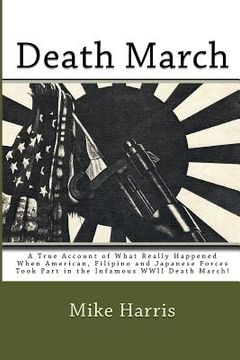Death March: A True Account of What Really Happened When American, Filipino and Japanese Forces Took Part in the Infamous WWII Deat (en Inglés)
Reseña del libro "Death March: A True Account of What Really Happened When American, Filipino and Japanese Forces Took Part in the Infamous WWII Deat (en Inglés)"
Donald Knox wrote DEATH MARCH in the 1980's, this is a screenplay based on Donald Knox's book: General Douglas MacArthur retired as Chief of Staff of the U.S. Army in 1937 and became Military Adviser to the Commonwealth Government of the Philippines. When President Roosevelt thought Japan might cause trouble in the Pacific, he recalled General MacArthur back to active duty in 1941 as commander of all U.S. Army Forces in the Far East. In preparation for a possible Japanese attack, General MacArthur drew up plans that stipulated if U.S. forces couldn't hold back Japanese advances on Luzon, American and Filipino troops should do everything they could to delay the Japanese by making a slow retreat down the Bataan Peninsula, until additional troops and supplies could be sent from the U.S. On December 7th, 1941 the Japanese did cause great trouble in the Pacific when they attacked the Hawaiian Islands and destroyed a large number of naval vessels at Pearl Harbor. Many people don't know it, but eight hours later (it was December 8th in the Philippines) they also attacked the Philippine Islands and destroyed a large number of U.S. B-17 bombers sitting on the ground at Clark Field. In 1941 the U.S. Calvary was still the main fighting force in the Philippines. General MacArthur had few well-trained troops, few WWI tanks, few artillery pieces, little food and little ammunition. When Japanese General Masaharu Homma's 14th Army came ashore at Lingayen Gulf on December 22, 1941 he had a much larger force of well-trained troops, modern tanks, many artillery pieces and lots of food and ammunition. Consequently, there was little the American and Filipino forces could do to stop them. As MacArthur's battle plans dictated, the defenders of Bataan fought valiantly for months on end, day and night, against overwhelming odds and were able to slow the Japanese advance considerably. But when they reached the little town of Marivelles at the very tip of the Bataan Peninsula they could go no further. When Major General Edward King, Jr. surrendered 75,000 American and Filipino troops to Col. Mootoo Nakayama of the Japanese 14th Army on April 9th, 1941 it was the largest number of U.S. troops ever forced to surrender in the annals of American warfare. General Homma gave his officers orders to march the troops 65-miles north to a prison facility named Camp O'Donnell. He also ordered that there should be plenty of water and food given to the prisoners so that they would all arrive safely at their destination. But Homma's senior officer believed an army that surrendered should not be treated with any respect, so disobeyed Generalo Homma's orders and allowed his troops to kick, beat, shoot, bayonet and mistreat the American and Filipino prisoners unmercifully. They were also forced to remain standing at attention at Marivelles, all day and all night without food, water, or rest before the march even started. the prisoners were then marched day and night without stopping to rest, without water and without food. If a prisoner stopped for any reason he was immediately shot and left to rot. If any prisoner dared stop to help, he was also immediately killed on the spot. It's really a miracle that any of the American and Filipino troops survived. "Death March" tells the true story of what really happened between the American, Filipino and Japanese soldiers during this horrific march to Camp O'Donnel. Ferdinand Marcos was a Third Lieutenant in the Philippine Army and took part in the infamous Death March. As did Ramon Monching Magsaysay. Both survived. Lt. Monching became president of the Republic of the Philippines in 1953, and Lt. Ferdi became president in 1965.

